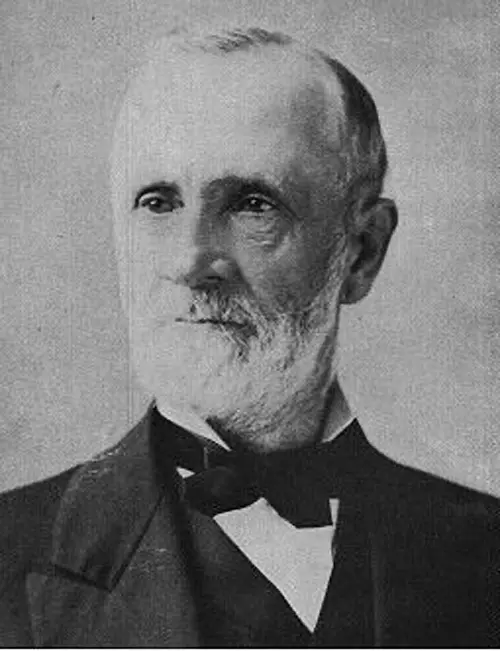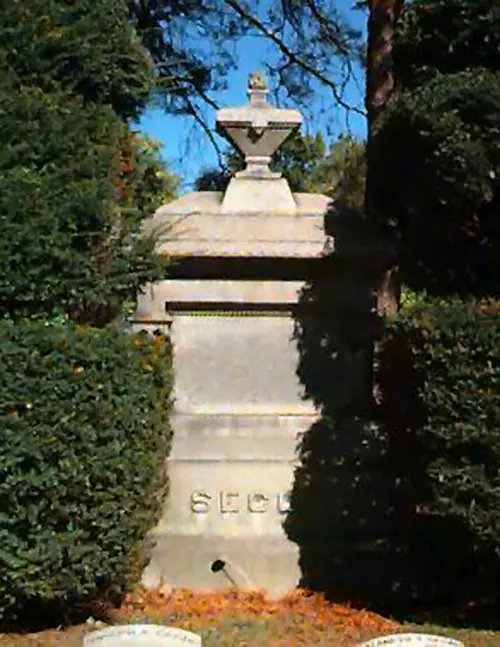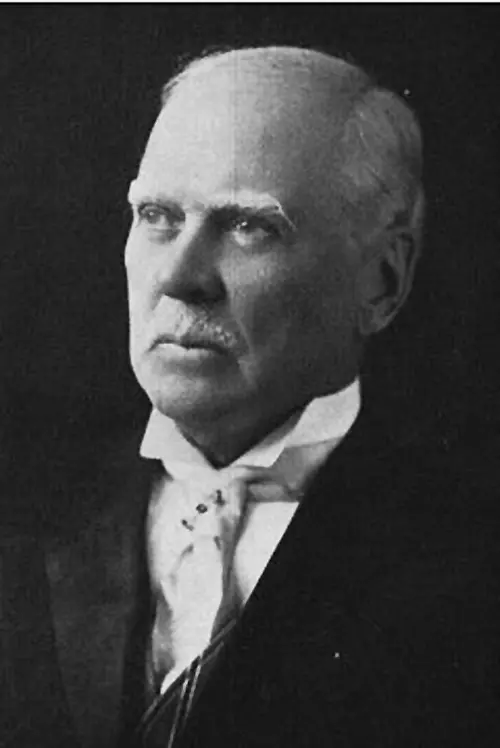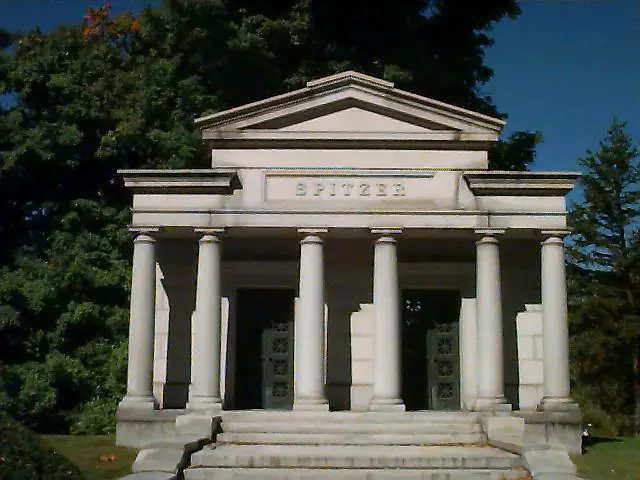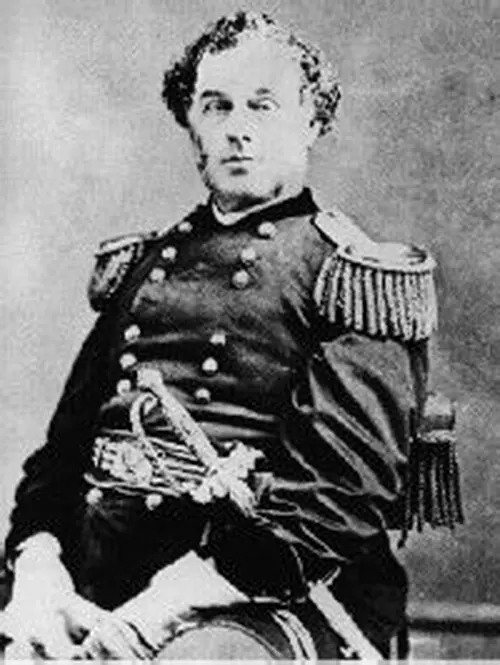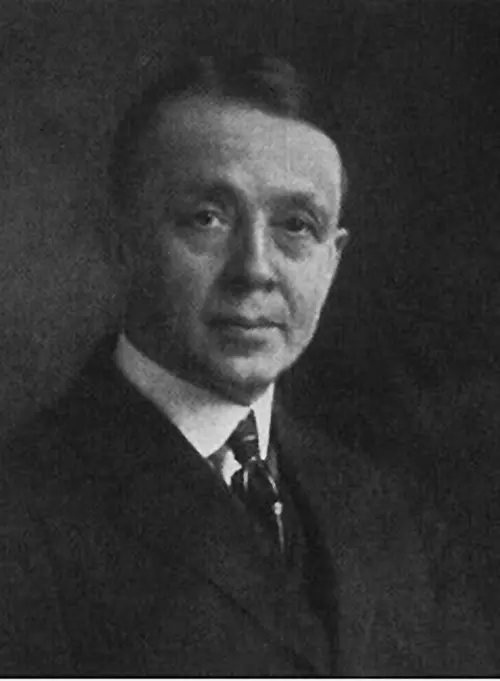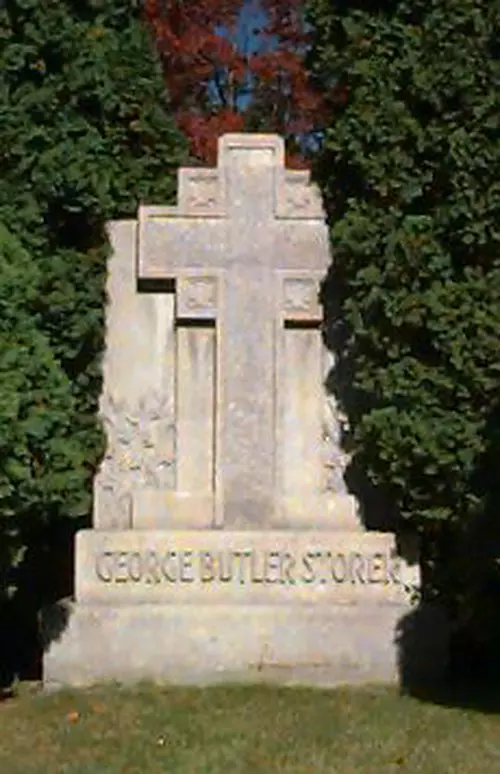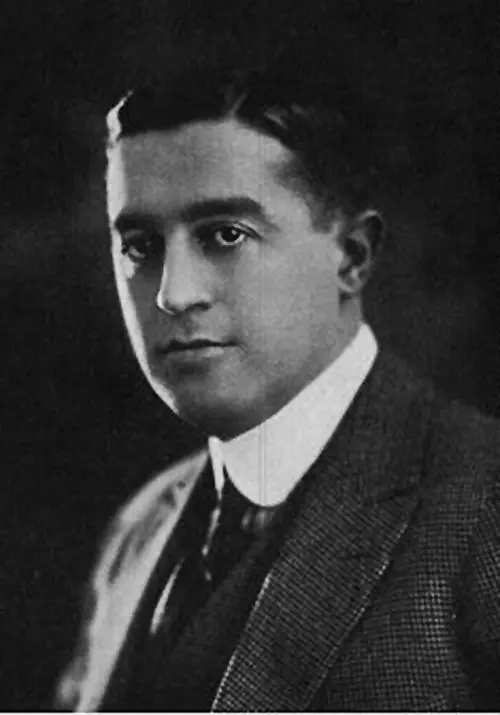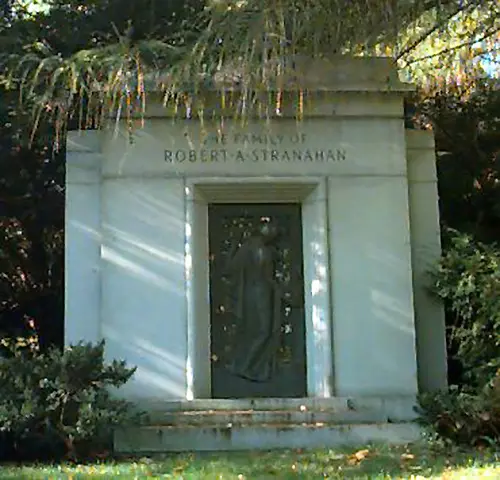William H. Scott - Jay K. Secor - James Secor - Joseph K.Secor - Gen. Isaac R. Sherwood - Spitzer Family - Gen. James B. Steedman - George Butler Storer - Robert A. and Frank D. Stranahan
William H. Scott
William H. Scott, a realtor by profession, helped to establish the second free public library in the region, served as president of the board of directors of The University of Toledo founded by his father, Jesup W. Scott, and was a trustee of Woodlawn Cemetery.
Scott was born in 1825 to Jesup W. and Susan (Wakeman) in Columbia, South Carolina. The family moved to the Maumee Valley in 1833 and settled in Toledo in 1844 where his father became the editor and part-owner of the Blade.
Scott was involved in real estate from the time his family moved to Toledo, but he also pursued literary studies and research throughout his life. Most of this research was directed toward public affairs and the improvement of the city. Along with his brother, F.J. Scott, he sought to improve the metro park system. In 1873, he wrote the bill requesting the establishment of a public library which was introduced in the State Legislature by T.P. Brown. Scott was also active in the suffragist movement and served as vice-president of the Toledo Woman's Suffrage Association from 1876-79.
Scott served on The University of Toledo Board of Directors for a number of years. His father donated, in 1872, 160 acres of farm land to be used as the site of a manual training school. The Toledo University of Arts & Trades opened in 1875 and offered architecture and painting courses as well as manual training. The school closed in 1878, but was reopened as a municipal institution in conjunction with the Toledo Board of Education in 1884. As a manual training school, it was one of the first of its kind in the United States, and schools looked to it as a model.
His affiliation with educational institutions also extended outside of Toledo. He served as a trustee of Ohio State University and was on the board of directors for both Wesleyan College and the Adrian Public Schools.
Scott married Mary A. Winams of Adrian, Michigan, in 1851. He died March 5, 1901.
Jay K. Secor
Jay K. Secor, son of James Secor, was born in Toledo on April 28, 1872. He was a Toledo banker and broker. Jay graduated from the Toledo public schools, then Andover Academy in Massachusetts. He returned to Toledo and became employed at the Northern National Bank. He worked there in various capacities for several years. Later in his life, he returned to the bank as a vice-president and director.(Toledo Biography Scrapbook, Local History Room, Toledo Lucas County Public LIbrary). He became a partner in the firm of Secor & Bell, established in 1898, which became Secor, Bell & Beckworth in 1920. This company was one of the first in the Toledo area to open a direct, private line to the New York stock exchange. It was a dealer in stocks and bonds as well as handling the securities and financial transactions in Toledo.
Jay was also president of the Citizens' Ice Company, president of the Toledo Bridge & Crane Company and Vice-president of the Union Savings Bank. He was a director of many companies including the Toledo Steamship Company and the W.L. Milnek Department Store. He had an active social life and was especially interested in outdoor activities. He belonged to numerous clubs including the Toledo Club, The Toledo Country Club, the Chamber of Commerce, Castalia Fishing Club of Ohio, the Erie Shooting Club, the National Golf Club of Ohio, the Dartmouth Salmon Fishing Club of Quebec, and the Ohio Society of New York. Jay Secor was a charitable man who was a leader of the Red Cross drives during World War I. He also served as a trustee of the Toledo Museum of Art
Jay was the president of the firm that constructed and owned the Secor Hotel, which was opened August 1, 1908. The hotel was named in honor of Jay who had done much to promote the new building. Painted portraits of James and Joseph Secor hung inside.
Jay Secor was ill the last two years of his life which seriously limited his business activities. He had left for Florida as part of a vacation intended for his health. He died there on February 21, 1921 at the age of 48. It was believed that his death was caused by heart disease.
Jay Secor married Mary Young Barnes on his birthday in 1898. She was the daughter of G.W. Barnes of Colorado. It was estimated that Secor's estate was worth between $4,000,000 and $5,000,000.[Harvey Scribner, ed., Memoirs of Lucas County and the City of Toledo, vol.2 (Madison: Western Historical Association, 1910), p.522].
James Secor was born in Goshen, New York in 1834, the son of Benjamin and Sarah (Ketcham) Secor. In 1844 he and his family moved to Michigan. He worked on the family farm until the age of twenty. It was in that year that he moved to Toledo. His brother Joseph was a partner in the wholesale grocery business of Secor, Berdan and Company, and James was made clerk of the company. He was so successful with his new job that in 1858, James became a partner and was made general manager. Previously, the company had supplied country stores with not only groceries, but also dry goods. The sales of the company, until James became manager, had been around $250,000. After James dropped dry goods in 1860, the profits increased 100%. Eventually Secor, Berdan & Ketcham became one of the leading grocers in Ohio and the surrounding area. James remained manager until his retirement in 1888.
When he retired, James turned his attention to the banking world. He helped to organize such institutions as the Union Safe Deposit and Trust Company, the Union Savings Bank, and the Woolson Spice Company. He served as president of all three companies.
James was a member of the Toledo Club, the Toledo Country Club, the Middle Bass Club, and the First Congregational Church. In January, 1867 he married Charlotte A. Steele. The couple had four children, only one of which, Jay K., survived. James was a member of the Republican party and was a keen hunter. In 1901, while James Secor was hunting in a marsh, he collapsed and died aged only 66 years. He is buried in Woodlawn Historic Cemetery in Section 5, lot 42.[Harvey Scribner, ed. Memoirs of Lucas County and the City of Toledo vol. 1 (Chicago: S.J.Clarke Publishing Company,1923), pp.103-104. John M. Killits, ed., Toledo and Lucas County, Ohio 1623-1923 vol. 3 (Chicago & Toledo: S.J. Clarke Publishing Company, 1923), p.673].
Joseph K. Secor was born in 1822 in New York. He was the eldest son of Benjamin and Sarah (Ketcham) Secor and the brother of James Secor. In 1840, Joseph came to Toledo. On his arrival, he entered the employ of Valentine H. Ketcham who was in the wholesale grocery trade. He became the partner of Mr. Ketcham and the company name was changed to Ketcham & Secor. In addition to dealing in wholesale groceries, the company was known as a private banking house until 1863. Joseph Secor helped organize it into the First National Bank after the National Banking Act of 1863. He became its director and vice-president. It was a position he held until January 1, 1890.
Joseph K. Secor also served on the Toledo City Council in 1873. He was on the advisory board of the Toledo Industrial School as well. In 1850, he married Elizabeth Ketcham. They were the parents of two children.
In 1850 Peter F. Berdan joined the company. He later became a partner when Ketcham retired in 1854. The company name was changed to Secor, Berdan & Company. Joseph K. Secor remained with the company until he retired in 1888. On April 16, 1892, Joseph Secor died. Elizabeth Secor died on May 28, 1911. He is buried in Woodlawn Cemetery section 85, lot 10.[Toledo Biography Scrapbook, Local History Room, Toledo Lucas County Public Library. Charles S. Van Tassel, ed., The Story of the Maumee Valley, Toledo and the Sandusky Region. (Chicago: S.J. Clarke Publishing, 1929), pp.225-28. See also Harvey Scribner, ed., Memoirs of Lucas County and the City of Toledo, vol. 2. (Madison: Western Historical Association, 1910), p.522].
Gen. Isaac R. Sherwood
General Isaac R. Sherwood was born in Stanford, Dutchess County, New York on August 13, 1835. One of Sherwood's ancestors, Dr. Thomas Sherwood, sailed in 1634 from Ipswich, England to the New World. Sherwood's grandfather served in the American Revolution with the Cavalry and was with General Gates at the Battle of Stillwater, 1777. He was also a member of the New York legislature as well as a local magistrate. Sherwood's father, Aaron Sherwood, served in the War of 1812 and was also an inventor, making improvements on mill and farm machinery.
Early on, Isaac Sherwood's uncle dissuaded him from entering West Point Military Academy. Instead, he enrolled in the Hudson River Institute in New York in 1852. Two years later he traveled to Ohio to attend Antioch College where the acclaimed Horace Mann was president. Another two years passed and Sherwood transferred to the Ohio Law College in Poland, Ohio.
After completing his education, Sherwood relocated to Bryan, Ohio where he bought the Williams County Gazette in 1857. The Gazette was an abolitionist newspaper that Sherwood put in full mourning after John Brown was hung in 1859. He also served as probate judge of Williams County. In 1861, Sherwood's attention shifted towards President Lincoln's call for volunteers. Sherwood enlisted as a private in the Fourteenth Ohio Infantry under Colonel James B. Steedman. Sherwood's outfit saw action in West Virginia during the early days of the war. Four months later he returned home and was ill during the summer of 1861. In September, 1862, he joined the 111th Ohio Volunteer Infantry at Toledo. In February of the next year he was promoted to Major. His regiment spent a harsh winter in East Tennessee in 1863 and 1864. Sherwood shared the suffering along with his men. Later, Sherwood was complemented for his brave conduct at the battle of Campbell's Station. In February 1864, he was promoted to Lieutenant-Colonel.
Sherwood's regiment was a part of General Sherman's Atlanta campaign in the summer of 1864. At Lost Mountain, he led his regiment in a charge down the slopes of Resaca. The second brigade lost 679 men out of the 1800 who took part.
Sherwood played an important part in defeating General Hood's Confederates at Franklin, Tennessee on November 30, 1864. The Ohio civilians in Tennessee expressed their thanks by presenting him with a sword and silver scabbard. Sherwood's efforts were rewarded as he gained the respect of the other soldiers as well as the title of brigadier-general by President Lincoln on February 16, 1865.
At the conclusion of the war, the General returned to Ohio and to his interest in journalism. He moved to Toledo and served as editor of the Toledo Commercial. At that time he was also a member of the editorial staff at the Cleveland Leader. In 1875 he purchased the Toledo Journal and edited it for nine years. He was associated with the Canton News Democrat from 1888-1898. Aside from editing and writing for papers, Sherwood served as the Secretary of State in 1868 and again in 1870 for four years. He is noted for organizing the Bureau of Statistics. In 1872 he was elected as a Republican to serve the sixth district in Congress. He conflicted with the party leaders over the money question and was denied renomination. In 1878, representing the National or Greenback ticket, Sherwood was elected probate judge of Lucas County. He was reelected in 1881 as a Democrat and Independent.
After moving to Canton in 1896, Sherwood decided to run again for Congress. Canton was also the home district of then Presidential candidate, William McKinley. As part of his campaign, Sherwood criticized McKinley's war record. He failed to win a seat in Congress in 1896. After the election, he returned to Toledo. Continuing in public service, Sherwood accepted Congressional nomination in 1906 in the Ninth Ohio (Toledo) district and was triumphant.
At Age 71, he was one of the two oldest members of the House. Sherwood was elected every year until 1920. He lost that year, but returned two years later. At age 87, he was then America's oldest congressman.
Sherwood distinguished himself many times in his congressional career. He pushed through his "Dollar-a-Day" bill which increased the pensions of Civil War veterans. In 1916 he expressed pacifist opposition to the Wilson administration's WWI measures. On a trip to Toledo, President Wilson rebuked Sherwood. Despite this, Sherwood garnered his biggest victory ever in the fall elections.
Isaac Sherwood was a member of the fraternity of Masons and Odd Fellows and of Forsyth Post, No. 15, Department of Ohio, Grand Army of the Republic. In addition, he was a member of the Society of the Army of the Cumberland and the Army of the Ohio. He contributed a war poem at the first reunion of the Army of the Ohio at Cincinnati in 1866. He married Katherine Margaret Brownlee in September, 1859 and they had two children.[Clark Waggoner, ed., History of Toledo and Lucas County Ohio (New York: Munsell & Company, Publishers, 1888), pp.198-200. See also Harvey Scribner, Memoirs of Lucas County and the City of Toledo: From the Earliest Historical Times Down to the Present, including a Genealogical and Biographical Record of Representative Families, vol. 2 (Madison: Western Historical Association, 1910), pp.18-20;( "General Sherwood Dies at Home Here After Great Career as Soldier-Solon," Toledo Times, 16 October 1925) and ("Defeat of 'The General': Public Career of Distinguished Citizen," Toledo Blade, 3 November 1970)].
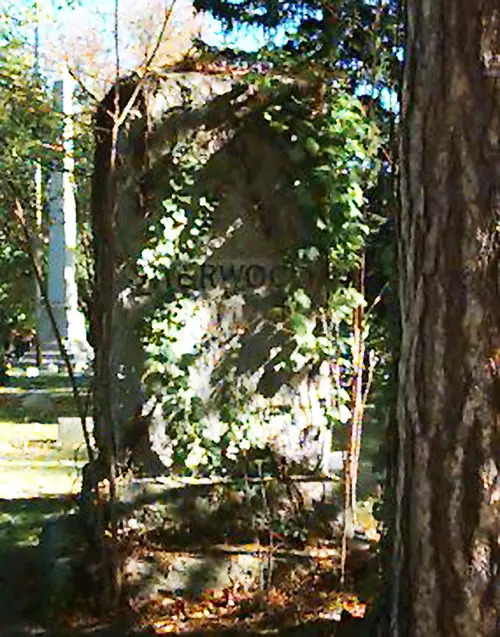 Gen. Isaac R. Sherwood's grave
Gen. Isaac R. Sherwood's grave
Spitzer Family
Ceilan Milo Spitzer, co-founder of Spitzer, Rorick & Company, was a prominent merchant and banker who contributed to the material development of Northwest Ohio.
Spitzer was born in Batavia, New York on November 2, 1849 to Aaron Bovee and Laura Maria (Parkins) Spitzer. His family moved to Medina, Ohio in 1851. He attended public schools and Oberlin College. In 1869, he began his business career by purchasing a half interest in a drug store in Seville, Ohio. He conducted business there for two years and then sold out, becoming an active associate of his father in opening the Seville Exchange Bank, C.M. Spitzer & Company.
The company was successfu. A branch was opened in Medina in 1877 and they organized the German-American Bank of Cleveland in 1878. In January 1880, the bank failed in the midst of a depression. Ceilan Spitzer had to settle with his creditors on 40% terms. It was a testament to his good character and business sense when he voluntarily paid the remainder of the debt ten years later. The Spitzers opened a bank in Fremont, Ohio in 1880, but sold it the following year. It was at this time that the firm of Spitzer, Wideman & Company of Toledo was organized. Spitzer purchased the interests of his partners the following year, in 1882, and was joined by his cousin, Adelbert L. Spitzer, under the firm name of Spitzer & Company. Spitzer & Company became a very successful business. They were the first company west of New York City to engage in the buying and selling of bonds. It was known as "the father of the municipal bond business in the middle west."
Adelbert Lorenzo Spitzer became well-known for his connection with the municipal bond and investment business he entered with his cousin, Ceilan Milo Spitzer.
Adelbert was born on a farm in Medina, Ohio on August 15, 1852 to Garrett and Mary (Branch). He was educated in public schools in his county and at the Lodi Academy. He accepted a position at the Exchange Bank of Seville, Ohio in December, 1872. In September, 1873 he joined his brother, Amherst T. Spitzer, in establishing the Bank of North Amherst under the firm name of Spitzer Brothers. On October 20, 1875 he married Sarah Elizabeth Strong. Spitzer Brothers was so prosperous that two years later he bought her one of the largest and most attractive homes in North Amherst. He purchased his brother's interest in the firm in 1878 and in 1882, he decided to close the business and move to Toledo. It was at this time that Adelbert joined his cousin, Ceilan Milo.
In 1887, Spitzer & Co. established a branch office in Boston which, in May 1899, was removed to New York City. A partnership change in February, 1911 led to the name change of Spitzer, Rorick & Company. The company's prominence had a strong effect on the other bond houses in Toledo. At one time, most of the heads of all the other bond houses in Toledo had received their training either directly or indirectly from Spitzer & Co.
Ceilan Spitzer remained active in the affairs of the corporation until his retirement due to ill health in 1913. Adelbert continued with the company for another eight years. Ceilan was also associated with many banking institutions of Ohio as a stockholder and director. He served as a director of the Wheeling & Lake Erie Railroad and was the first president of the Spitzer Building Company. Toledo's first fireproof, steel office building was erected in 1893 by the Spitzer Building Company. It was also known for building the sixteen story Nicholas Building. Ceilan also became president of the Nicholas Building Company. With his cousin, Adelbert, they owned these buildings jointly for a number of years, but divided the ownership in 1911.
In January, 1900, Cielan Milo Spitzer was appointed Quartermaster General of Ohio by Governor George K. Nash, with the rank of Brigadier General, and gained the title by which he was generally known. When Ceilan Spitzer was not working he could many times be found traveling abroad. He was a member of the Royal Automobile Club of England and enjoyed taking driving tours of Europe. At home he was a member of the Toledo Club, the Bankers Club of America, and Ohio Society of New York.
In 1884, Ceilan Spitzer married Lilian Cortes McDowell. He died on February 18, 1919. Lilian died on June 18, 1917.
Adelbert Lorenzo Spitzer decided to sell his interest in Spitzer, Rorick & Company in 1921. He continued to manage the Spitzer Building and look after his other banking concerns.
Adelbert was never so busy that he did not have time for himself or the community. In 1909, he served as the Director General of Toledo's King Wamba Carnival. The outbreak of World War I, found Adelbert as the President and General Manager of the local field Red Cross Society.
In his leisure he enjoyed his horses. He had a fine stable and won many blue ribbons at horse shows. He was a member of many social organizations including being a founder and director of The Toledo Club. He was the first president of The Toledo Country Club. He also had memberships in the Toledo Yacht Club, and the Ohio Society of New York. His wife, Sarah, died on July 17, 1914 at the age of 60. Adelbert died June 11, 1933 at the age of 81.
Thomas Pim Goodbody married Luette Ruth, (b. March 14, 1882) the daughter of Adelbert Lorenzo and Sarah Elizabeth (Strong) Spitzer, on November 9, 1904. They had six children. Goodbody graduated from Williams College and was engaged in the investment banking business, and was a member of the Goodbody family which was prominent in New York financial circles. He died June 8, 1955 at the age of 77.
Lyman Spitzer Sr., built the Spitzer Paper Box Co., which he reorganized from the National Paper Box Co. into a major industry in Toledo. He was also involved the bond and investment field and was manager of the National Bank Building.
Lyman was born on February 2, 1880 in Amherst, Ohio to Adelbert Lorenzo and Sarah Elizabeth (Strong). He received his education in Toledo and at the Phillips Academy in Andover, Massachusetts. He graduated from Yale University in 1902 and joined the New York branch office of Spitzer & Company, where he remained for one year.
Spitzer then spent a year in Maine as a traveling representative of the bond department, then returned to Toledo in 1905 where he joined the Spitzer company for three years. He became involved with the real estate end of the business and was the manager of the Spitzer and Nicholas buildings for ten years.
In 1915 he purchased the controlling interest in the National Paper Box Company and remained active in the management of the business until he joined the Army, where he was made Captain, during World War I. Upon his discharge in 1918, he reorganized the paper box business under the name of Spitzer Paper Box Company.
Spitzer served as a Toledo Councilman, was a nominee for state senator in 1920, served as president of the Boy Scout Council, and was a member of the Toledo Chamber of Commerce. As a member of the Park Board he campaigned for twelve years to have benches put under shade trees downtown. Eventually he was successful and they were placed in Courthouse Square.
Lyman Spitzer made the most out of the time he had to himself. Mr. Spitzer very much enjoyed books and owned thousands of them on art, music, and literature. Mr. Spitzer often invited guests of the Town Hall Lecture Series to his house for luncheon. His notable guests included H.G. Wells, Robert Noyes, and Robert Frost. He was the owner of a copy of "North of Boston" by Frost where the poet had put inscriptions for 1917, 1927, and 1941.
He and his family traveled the world. He liked to live in a city like London, Paris, or Rome for months. This enabled him to take full advantage of the city's' culture and atmosphere.
On September 19, 1906, he married Blanche Carey Brumback. They had four children. Spitzer died April 1, 1979 at the age of 99. Blanche died January 3, 1956 at the age of 72.
Carl Bovee Spitzer held a prominent position in the financial life of Toledo as a partner in the firm of Spitzer-Rorick & Company, and the vice-president of the Spitzer-Rorick Trust & Savings Bank.
Spitzer was born February 7, 1877 in Amherst, Ohio to Adelbert Lorenzo and Sarah Elizabeth (Stront). The family moved to Toledo when he was five years old. Spitzer graduated from the Toledo High School in 1894 and attended Phillips Academy in Andover, Massachusetts for one year. He graduated from Yale University in 1899 with a Bachelor of Arts degree.
He joined the bond house of Spitzer & Company which his father founded. He was later one of the organizers of the Spitzer-Rorick Trust & Savings Bank. At one time he served as vice-president of the Trust & Savings Bank. In 1927, he left it to devote his attention to the management of the Spitzer Building. When his father died in 1933, he became the president of the Spitzer Building Company.
Carl Bovee Spitzer was a prestigious member of several organizations. He was a president of the Toledo Symphony Orchestra in the 1920s. He became a trustee of the Toledo Museum of Art in 1907. When he resigned 47 years later, the board bestowed on him honorary membership. During his time at the museum, he had served as vice-president and on the executive committee. He himself took up painting at the age of 70. One of his greatest honors was presenting his one-man show at the Museum in 1951.
Spitzer also served as President of the Toledo Commerce Club, and was active in the Federated Charities. During World War II he was chairman of the Toledo Chapter of British War Relief.
Carl Spitzer also displayed a great interest in history. He was a member, and at one time secretary, of the Northwestern Ohio Historical Society. After leaving the Spitzer-Rorick Trust & Savings Bank he spent eighteen months on an archaeological dig in Greece.
On September 14, 1904 he married Edna Josephine Brown. Spitzer died on December 15, 1962 at the age of 85. Edna died June 2, 1964 at the age of 83. [John M. Killits, ed. Toledo and Lucas County, Ohio, 1623-1923, vol. 2 (Chicago: S.J. Clarke Publishing Co., 1923), pp.353-354, 413-414, and 523-526. See also Randolph C. Downes, ed. History of Lake Shore Ohio: Family and Personal History, vol. 3 (New York: Lewis Historical Publishing Co., 1952), 473-474 and Toledo Biography Scrapbook Local History Room, Toledo Lucas County Public Library].
Gen. James B. Steedman
General James Blair Steedman was born July 29, 1817 in Northumberland, Pennsylvania. He was the second of five children. Steedman was fifteen when his parents died. To support the family, Steedman became employed as a typesetter for the Lewisburg Democrat. Two years later, he moved to Louisville, Kentucky where he filled the same job for the Louisville Journal.. His first experience at war came when he fought alongside Sam Houston to help establish an independent Republic of Texas.
After the war, Steedman returned to Pennsylvania where he became a supervisor on a public works project. In 1838, he moved to Northwest Ohio with the idea of becoming a contractor. After failing to find work, he purchased a printing press in Napoleon. He published the first edition of the Northwest Democrat in 1838. During that time he married his first wife, Miss Miranda Slides.
A short time later he began to prosper as a contractor. He was awarded the contract to build the Wabash & Erie Canal. More contracts followed and his firm was employed on the construction of the Toledo, Wabash & Western Railroad.[Harvey Scribner, Memoirs of Lucas County and the City of Toledo, vol. 2 (Madison: Western Historical Association, 1910), p.166].
As he prospered, Steedman found another career in politics. In 1847, he began his first of two terms in the lower house of the Ohio Legislature. In 1849 Steedman headed west to take part in the gold rush in California. After a year, he returned to Ohio. From 1852-1857, he was on the board for public works. For three out of four years he was its president.
In 1857, he was elected to the position of congressional printer and Major General of the Fifth Division of the Ohio Militia. He held that position until the outbreak of the Civil War in 1861. During the period 1857-1861 he was editor of the Toledo Times. At the same time he was admitted to the Ohio Bar Association and soon after established a Toledo law practice. In 1859, he funded and served as editor of the Democratic Toledo Times newspaper.
Steedman was a member of the Ohio Delegation to the Democratic National Convention in Charleston, South Carolina. Steedman stood on the side of the Northern Democrats who nominated Stephen Douglas in Baltimore. Also in 1860, he ran for the Toledo Congressional District but lost to the Republican candidate, General Ashley.
After Fort Sumter was fired on in 1861, Steedman urged people in the Times to support President Lincoln's administration. He was in charge of forming the Fourteenth Ohio Volunteer Infantry in which he became a Colonel. On July 16, 1862, he was promoted to Brigadier General of the Volunteers and was ordered to join General Buell's army of the Kentucky where he made brilliant maneuvers to enforce the Union position. On October 8, 1862, at the Battle of Perryville, Kentucky, his brigade reinforced General Rasseau's division of Cook's Corps and saved it from being pushed from the field. Steedman received a high commendation in General Buell's report.Scribner, 166. He took part at Stones River in December 1862. During the Tullahana Campaign the next year he received a Division. In July of 1863 he was assigned to the command of the First Division of the Reserve Corps under Major General Gordon Granger.
General Steedman's decision to reinforce General George Thomas's men at Chickamauga prevented a disaster. On September 20, 1863, Confederate General Longstreet took advantage of a break in the Union lines to split the right and left flanks. The Union right retreated North to Chattanooga. General George Thomas tried to stop the Confederate advance at Hershey Ridge. Aware that Thomas was facing the entire Confederate mass, Thomas and Granger brought their reserves to his aid.
When Granger ordered a charge, Steedman grabbed the colors and led his men forward.(Ibid., p.140). Steedman's division lost a fifth of its strength in the first twenty minutes. His horse was shot out from under him. He was so certain he was going to die that he implored a staff officer to make sure his name was not misspelled "Steadman" in his obituary.(Encyclopedia entry for James Blair Steedman. Book unknown. Attached to the back of copy of Toledo Lucas County Library entry on Steedman). Steedman held his position and drove the Confederates from the field. His aid to Thomas was crucial in allowing the Union to make a safe retreat to Chattanooga. His comrades honored him with the name "Old Chickamauga."(Scribner, p.161). Steedman was promoted to Major-General as a result. Steedman served with General Sherman during the Atlanta campaign and also with Thomas at the Battle of Nashville in December 1864.(Killits, p.169).
After the war, Steedman held several posts in the Reconstruction South. He was in command of the Georgia Military District until July 1866. At that time he resigned his Army post. Steedman's name was suggested as Secretary of War for Andrew Johnson. However, he would became the Collector of Internal Revenue at New Orleans until 1869. He then returned to Toledo where he served as editor of the Northern Ohio Democrat until his death in 1883.
Steedman's final ten years proved to be just as prestigious as the years before. He was a delegate at the State Constitutional Convention in 1874, a State Senator in 1878 and a delegate again to the Democratic National Convention in 1880. In addition, in his final years, he was elected department commander for the Ohio Veteran's Organization, and the Grand Army of the Republic. His last public office was the Chief of Toledo Police. General Steedman died on October 8, 1883.[Charles S. Van Tassel, ed. Men of Northwestern Ohio (Toledo: Hadley Printing Co., 1898), p.382].
The city displayed their appreciation on May 26, 1887 by unveiling a large bronze statue of General Steedman.(Killits, p.166).
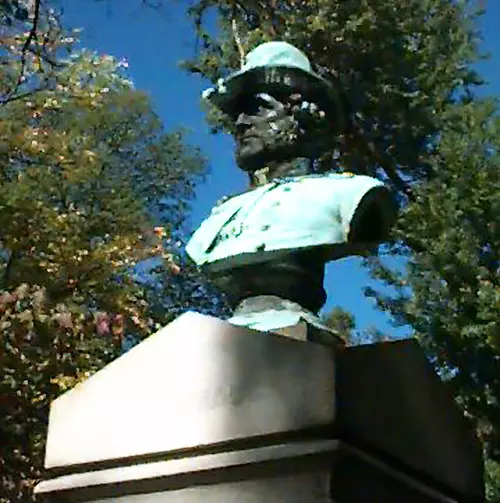 Gen. James B. Steedman's grave (front angled view)
Gen. James B. Steedman's grave (front angled view)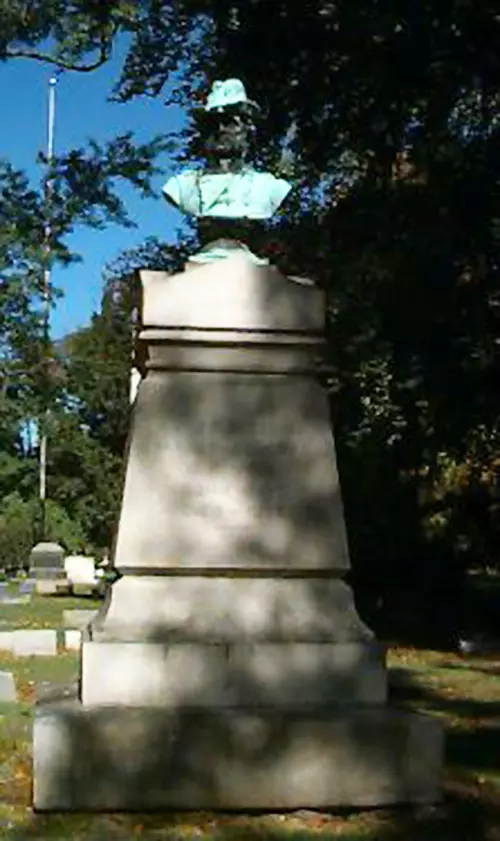 Front view
Front view
George Butler Storer was born on the first of January 1866 in Cuyahoga Falls, Ohio. Early in his life his parents moved to Shelby where he began school. Eventually he entered college at Oberlin. When he graduated he returned to Shelby and began working with his father on the family business, the Shelby Milling Company. In 1888, his father retired from the business and George took it over. At this time George began the Twin City Ice & Cold Storage Company in Champaign, Illinois.
The city of Toledo sought out Mr. Storer to fill a vacancy in the office of the secretary of the Toledo Chamber of Commerce. Once he was running the organization, the city government was greatly improved. He took many of the separate departments and put them under his control. This helped to reduce duplication of services. Under his control the Chamber of Commerce began to participate in charity, education, and civic development. After four years he resigned to return to business. He became involved with the Standard Steel Tube Company of Toledo. He soon became President and General Manager. He would stay in that position until his death.
On March 16, 1887 he married Mabel Mozier. They had three children, Francis Louis, Martha, and George Butler, Jr. George, Jr. eventually gained prominence himself through the founding of WSPD radio and his interests in Oil.
Storer was also a lover of nature and a history buff. The two interests came together as he beautified Sentinal Point which had been known as Battery Point in the War of 1812. Storer Camp in Stony Lake, Michigan was named after him because of his strong involvement in the Young Men's Christian Association.
The groups he was involved with had nothing but praise for Mr. Storer at the time of his death on December 5, 1920.[John M. Klllits, ed., Toledo and Lucas County, Ohio 1623-1923, vol. 1 (Chicago & Toledo: The S.J. Clarke Publishing Company, 1923), pp.232-236].
Robert A. Stranahan and Frank D. Stranahan
Robert A. Stranahan and his brother, Frank D. Stranahan, founded the Champion Spark Plug Company, one of Toledo's most prosperous and successful businesses. The company also established the Stranahans as pioneers in the automotive industry.
Their parents, Robert Allen and Elizabeth (Whitehill) Stranahan lived in Buffalo, New York where Frank was born in 1876 and Robert on July 7, 1886. Between 1888-1900, their father worked as the highly regarded proprietor of the well-known Tremont House in Boston. Frank Stranahan established a bicycle shop and auto accessory business in Boston. Robert Stranahan, Jr. attended public schools in Boston and Brookline, Massachusetts and graduated from Harvard University in 1908, setting a university record for taking four years of coursework in two and a half years.
Robert Stranahan worked in a real estate office after leaving college. He also developed an interest in automobile parts and began building magnetos, spark plugs, coils, and other parts essential to the locomotion of automobiles. In 1908 he convinced his brother Frank to join him in founding the Champion Spark Plug Company in Boston. Robert served as president of the company with Frank as vice-president and treasurer. Champion Spark Plug did not do well on the east coast so the Stranahans looked to the Midwest for the future of their company. They chose Toledo as a good location because the Willys-Overland Auto Company had its plant there. With their business $22,000 in debt, the Stranahans moved Champion to Toledo in 1910.
The Stranahan brothers helped to pioneer the automotive industry in the United States and prospered in the process. Until 1961, Champion Spark Plug had the rare distinction of being the Ford Auto Company's sole supplier of spark plugs. Frank served as vice president and treasurer of the company for forty-four years, at which time he became co-chairman of the board. Robert, in addition to being president and chairman of the board of the company, presided over the Champion Porcelain Company, Champion Spark Plug of Canada, Limited Company and Jeffery-DeWitt Insulator. He held positions at several other businesses including Woolsen Spice, Stranahan Harris, Columbia Motors and Toledo Trust.
A member of the Republican Party, Robert Stranahan attended the 1952 national convention as a delegate. He also held memberships in many social organizations including chapters of the Masonic Order, the Harvard Club, the Toledo and Maumee River Yacht Clubs, and the Historical Society of Northwestern Ohio. In his free time he enjoyed golfing and other sports. In 1948 Robert Stranahan sponsored the Banquet of Champions in Toledo which brought 24 heros from various sports to the city.
Robert Stranahan married his first wife, Agnes McColl, on June 3, 1908. The couple had five children. Later, Robert and Agnes legally separated and he married Page (Ellyson) Lewis, with whom he had two children. A daughter from his first marriage, Dorcas, died May 22, 1935 at the age of 21. Robert Stranahan died February 9, 1962 at the age of 75. His wife, Page, died May 11, 1968 at the age of 79.[Randolph C. Downes, ed., History of Lake Shore Ohio: Family and Personal History, vol. 3 (New York: Lewis Historical Publishing Co., 1952), p.22; John M. Killits, ed., Toledo and Lucas County, Ohio, 1623-1923 (Chicago: S.J. Clarke Publishing Co., 1923), pp.242, 245; and Toledo Biography Scrapbook, Local History Room, Toledo Lucas County Public Library].
Frank Stranahan, a philanthropist, became actively involved in the community. He served as associate trustee for the Toledo Boys Club, honorary member of the YMCA Board of Trustees, member of the Friends of the University of Toledo Library, the Toledo Area Council of Boy Scouts of America, the Toledo Museum of Art, and the Toledo Chamber of Commerce, among other organizations. He married Marie Celeste, who died December 17, 1954 at the age of 78. They had one son, Duane, whose son, Duane, Jr., wed Elizabeth Spitzer Bentley in August 1952. Frank Stranahan died November 10, 1965 at the age of 89.(Toledo Blade, 10 November 1965 and The Toledo Times, 11 November 1965).
Robert Allen Stranahan III, who graduated from Ottawa Hills High School, held several positions in his father's company including administrator in the sales department. As a pilot, he supervised flight operations for Champion Spark Plug at its Toledo Express Airport installation. He married Mary Therese Urbanski and the couple had three children. An avid golfer, Robert Stranahan III helped to develop the former Byrnwick (Brandywine) golf course, serving as president of the club when it opened in 1967. On September 27, 1968, at the age of 27, he was killed in a one-car traffic accident.Toledo Blade, 27 September 1968. The Stranahans are buried in a family mausoleum at Woodlawn Cemetery.

